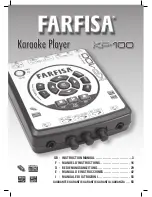
5
GENERAL INFORMATION
WARNING
To prevent the risk of property damage, personal injury,
or death due to fire, explosions, smoke, soot, condensation,
electric shock or carbon monoxide, thus unit must be
properly installed repaired, operated, and maintained.
This unit is approved for outdoor installation ONLY.
Rated performance is achieved after 20 hours of operation.
Rated performance is delivered at the specified airflow. See
outdoor unit specification sheet for split system models or
product specification sheet for packaged and light commer
-
cial models. Specification sheets can be found at
for Amana
®
brand products. Within the website,
please select the residential or commercial products menu
and then select the submenu for the type of product to be
installed, such as air conditioners or heat pumps, to access
a list of product pages that each contain links to that model’s
specification sheet.
To assure that your unit operates safely and efficiently, it
must be installed, operated, and maintained in accordance
with these installation and operating instructions, all local
building codes and ordinances, or in their absence, with the
latest edition of the National Fuel Gas Code NFPA 54/ANSI
Z223.1 and National Standard of Canada CAN/CSA B149
Installation Codes.
The heating and cooling capacities of the unit should be
greater than or equal to the design heating and cooling loads
of the area to be conditioned. The loads should be calculated
by an approved method or in accordance with A.S.H.R.A.E.
Guide or Manual J - Load Calculations published by the Air
Conditioning Contractors of America.
B10259-216
CO can cause serious illness including permanent brain
damage or death.
Advertencia especial para la instalación de calentadores ó manejadoras
de aire en áreas cerradas como estacionamientos ó cuartos de servicio.
B10259-216
El monóxido de carbono puede causar enfermedades severas
como daño cerebral permanente ó muerte.
Las emisiones de monóxido de carbono pueden circular a través
del aparato cuando se opera en cualquier modo.
B10259-216
RISQUE D'EMPOISONNEMENT AU MONOXYDE DE CARBONE
Le monoxyde de
des
carbone peut causer des maladies graves telles que
dommages permanents au cerveau et meme la mort.
Cette ventilation est nécessaire pour éviter le danger d'intoxication
au CO pouvant survenir si un appareil produisant du monoxyde
de carbone continue de fonctionner au sein de la zone confinée.
Obtain from:
American National Standards Institute
25 West 43rd Street, 4th Floor
New York, NY 10036
Transportation Damage
Check the carton upon arrival for external damage. If dam-
age is found, a request for inspection by carrier agent should
be made in writing immediately.
Carefully inspect the unit for damage including damage to
the cabinetry. Any bolts or screws which may have loosened
in transit must be re-tightened. In the event of damage, the
receiver should:
1. Make notation on delivery receipt of any visible
damage to shipment or container.
2. Notify carrier promptly and request an inspection.
3. In case of concealed damage, carrier should be
notified as soon as possible-preferably within 5 days.
4. File the claim with the following supporting documents:
a. Original Bill of Lading, certified copy, or indemnity
bond.
b. Original paid freight bill or indemnity in lieu thereof.
c. Original invoice or certified copy thereof, showing
trade and other discounts or reductions.
d. Copy of the inspection report issued by carrier
representative at the time damage is reported to
the carrier. The carrier is responsible for making
prompt inspection of damage and for a thorough
investigation of each claim. The distributor or
manufacturer will not accept claims from dealers
for transportation damage.
NOTE:
When inspecting the unit for transportation damage,
remove all packaging materials. Recycle or dispose of the
packaging material according to local codes.






































